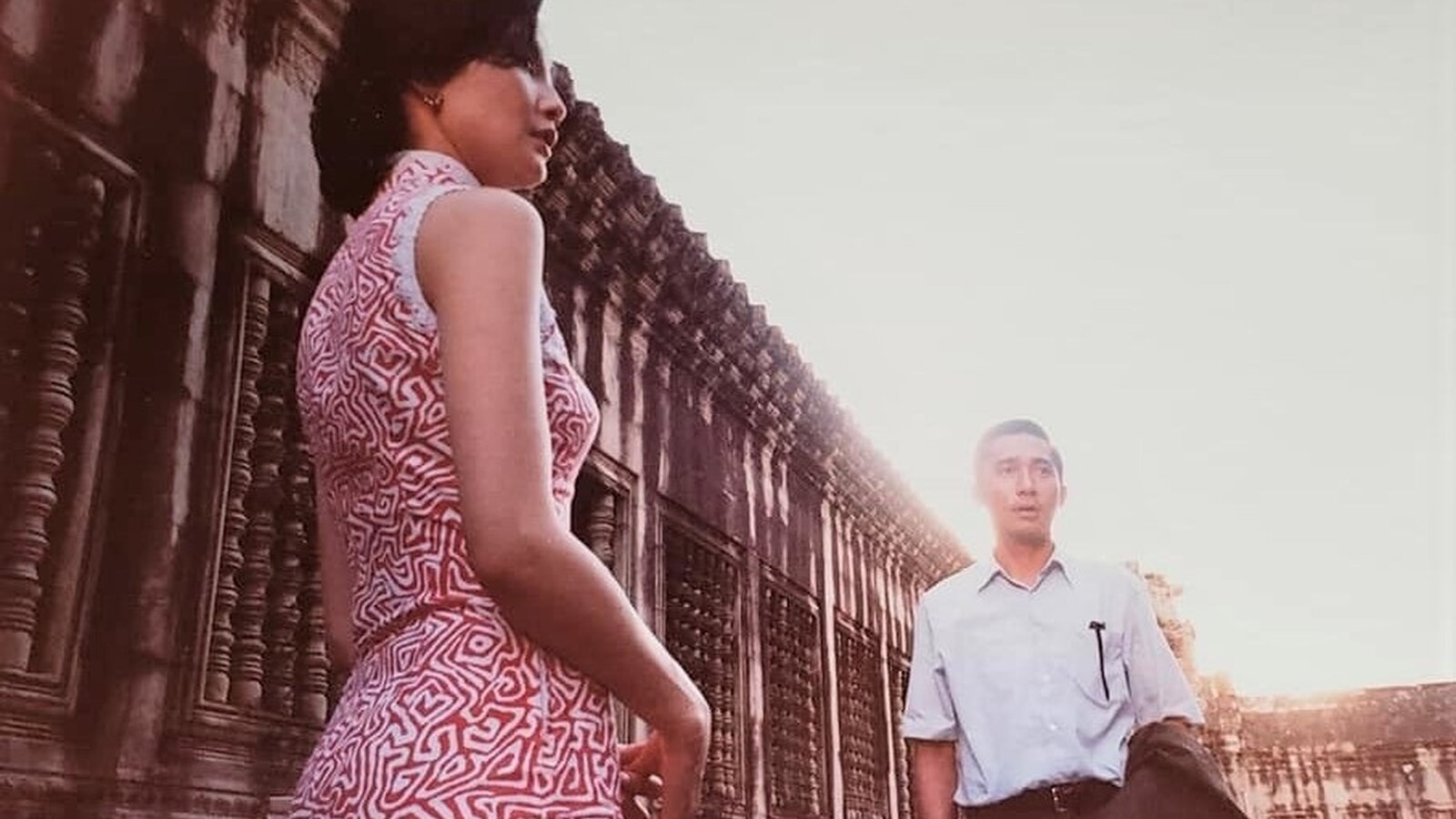
A brief reminder: In May 2000, In the Mood for Lovewas premiered and nominated for the Palme d’Or at Cannes Festival. The feature movie, mostly set in a dreamlike Hong Kong in the 1960’s and co-starred by iconic Maggie Cheung and Tony Leung Chiu-mai, has been recognized as the second best film of the 21st century. A 4K-restoration of the movie, under the supervision of cinematographer Christopher Loyd, was to be screened next month at the 2020 Cannes Festival, cancelled due to the pandemic.
Two neighbors in a Hong-Kong district populated by emigrants from Shanghai (like the movie director himself), Chow Mo-wan (Tony Leung) and Su-Chang Li-zhen (Maggie Cheung), find themselves gradually attracted one to each other while their respective spouses are having an affair. Are they actually falling in love, or somehow reenacting by proxy the breach of trust actually acted up by their partners?
Starting in 1962 Hong Kong, the plot moves on to Singapore, where Mo-wan-Tony was sent as a reporter, and Li-zhen-Maggie visits his apartment while he is out. She also calls him over the phone, once, but never speaks. In a deleted scene, they only meet againright in the middle of Angkor Wat. He is in Cambodia, supposedly to cover Charles De Gaulle’s official visit in September 1966, when the French president delivered in Phnom Penh a strong (and ineffective) call to the super-powers to de-escalate the war in Vietnam.

In Angkor, the two lovers-that-could-have-been (or actually were) exchange some small talk, then say their good-byes. Later, we are reminded of the recommendation to find a hole in a tree and whisper one’s deepest secrets into it.
Mr. Chow wanders through the magnificently puzzling temple structures, watched from afar by a young Cambodian monk. Finding a small excavation in a pillar – flanked by apsara bas-reliefs --, he gazes at it, then presses his mouth onto it, surrounded by bird songs and the sound of Angkor. Later, he leaves the precinct, while the camera lingers on Angkor pyres and a rising moon. The End.
And to begin with, behind-the-scene pictures...
Taken by Man Lim Chung (文念中), Art Director for the movie, these rare stills have been partly circulating on the Web from March 2019. We are first to credit their author.






Why Angkor?
"First, the story of Ms. Chang and Mr. Chow was supposed to be narrated from 1962 until 1972, with the beginning and the end in a Hong Kong profoundly changed during the whole decade", recalls Director Wong Kar-wai (in an interview with Positif film review in May 2000); "then we realized it was going on for too long, and we decided to end the movie in 1966. We were shooting in Bangkok, we looked for places in Thailand, then the idea of Angkor Wat came up. I've always wanted to see Angkor, so I said 'let's go'!"
Wong Kar-wai adds: "We wanted an ending 'with a distance', the two characters distanced from their usual surroundings. And the newsreel about De Gaulle arriving in Cambodia...more than the historical event itself, I liked the idea of showing another kind of waiting, the people of Cambodia waiting for something on the streets," waiting for a solution to the turmoil in South-East Asia at that time...
The Angkor scene before the final Director's cut
Chance meeting, whispering a secret to the stones, the mystery of Angkor and the magic of Michael Gassano's music...
More recently and only last year, during a Chinese-speaking online chat with movie buffs, the director had the following answer about his decision to elect Angkor for the movie ending: "Honestly, it is first because it is a place I always wanted to go. Secondly, Angkor Wat is a historical monument: the stones are silent, but they remember and witness the history of this place thousands of years ago. The ruins also reflect a glorious time that cannot be returned. In the movie, the two main characters find difficult to evade from each other, but there are no secrets and memories to return to."
Where in Angkor?
Angkor is literally made of millions of stone blocks -- 7 to 10, depending on how many satellite structures are counted in, and on ongoing architectural discoveries. And many, many of them are pierced with holes dating from the time of the built-up.
One of the first modern explorers of Angkor, Henri Mouhot, minitiously recorded that most of them are 2.5 cm in diameter and 3 cm in depth. The accepted explanation is that the blocks held temporary pegs in order to move them into their setting, and to be used a ladder steps for the workers to climb up to the upper parts of the sculptures.
From the camera angles in the movie's scene (especially when the monk observes Chow-Tony standing in front of the portico), and from the apsara bas-reliefs, we can identify the spot as the Southern Library on the upper esplanade in Angkor, the quincux surrounding the central pyre symbolizing Mont Meru.
In 2014, travel blogger Klaris came to the same conclusion, and here is her explorative account. For the present article, we went back to this exact spot on April 17, 2020:


To be continued...
In the Mood for Love final scene at Angkor opens up many questions that remain to be explored, including these:

A political message?
Wong Kar-wai being notiorously adverse to elaborate scripts, always moving on with intuitions and free association, we can only guess. And note that the 15-month long making of 'In the Mood for Love' coincides with the period when Hong Kong was reaching the end of its British colony status.
With its relatively smooth de-colonization background, and its firm stance as a non-aligned country during the Cold War convulsions, Cambodia could have been seen as an inspiration, if not a model.
(Photo: French President C. De Gaulle pays his respect to Princess Buppha Devi, King Norodom Sihanouk's daughter and the embodiment of Khmer classical dance renewal).

A spiritual one?
"I don't remember", cryptically replies Ms. Chang when Mr. Chow asks her in Angkor whether it was her who phoned him without uttering a word. Memories build the self, yet at the same time prevent us to reach the Buddhist state of 'no-self", untroubled mind.
While Western film critics have wandered to the psychoanalyse side ("catharsis", "repressed sexual pulsion"...), the spiritual significance of Angkor has been often overlooked.
(Here, researcher Hewaon Choi reflects on Buddhist themes in Wong Kar-wai's body of work, especially 'Ashes of Time' movie)

Judging by the extent of acknowledgments to Cambodian officials and citizens in the movie closing credits, we can assume that the "Angkor part" was intended to be rather substantial before last-minute editing cuts. Will the 4K restored version include the last scene in full?

Was it a daydream? The reporter is asked by a Japanese female tourist to take a picture of her in Angkor, looks up from the camera lens, and sees the woman he has loved for six years. Fantasy or not, the moment helps him to confide his secret to the temple...and to go on.

And, in closing, a recurrence: in '2046', Wong Kar-wai following movie after 'In the Mood for Love', the same character, Chow Mo-wan, sees Li-zhen-Maggie in flashbacks. But there is one more Li-Zhen, a professional gambler played by world-famous Gong Li. When she vanishes from the plot, we hear she came back to...Phnom Penh, where she is from.


Photo credits: - All stills of behind-the-scene in Angkor (including monk in the hallway): Man Lum Ching - Angkor Upper Level nowadays: Sakphearoth Kea - Movie Posters: Criterion Collection and FilmArtGallery
Quotes and research in Chinese: Lin Bo
Do you have any recollection of the In The Mood for Love crew in Angkor, years 1998-1999? Share it with us here.



